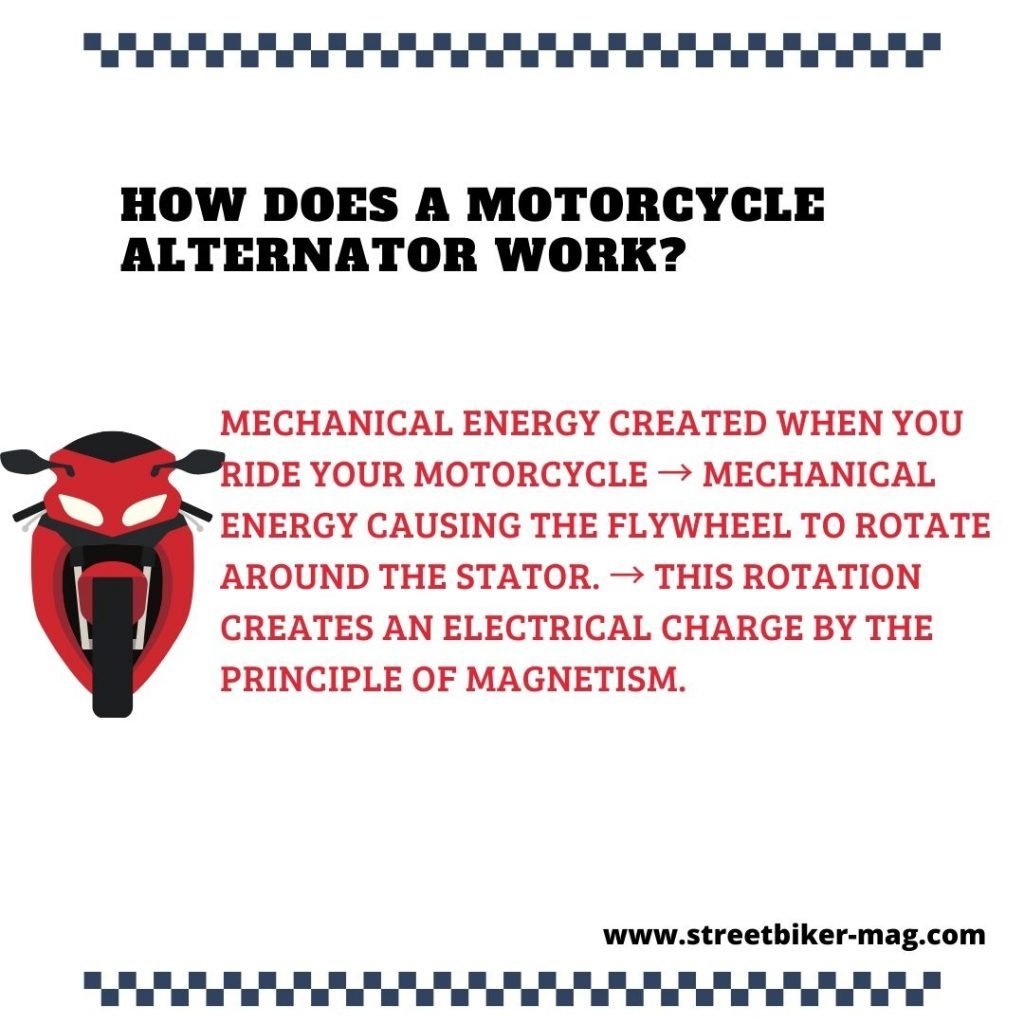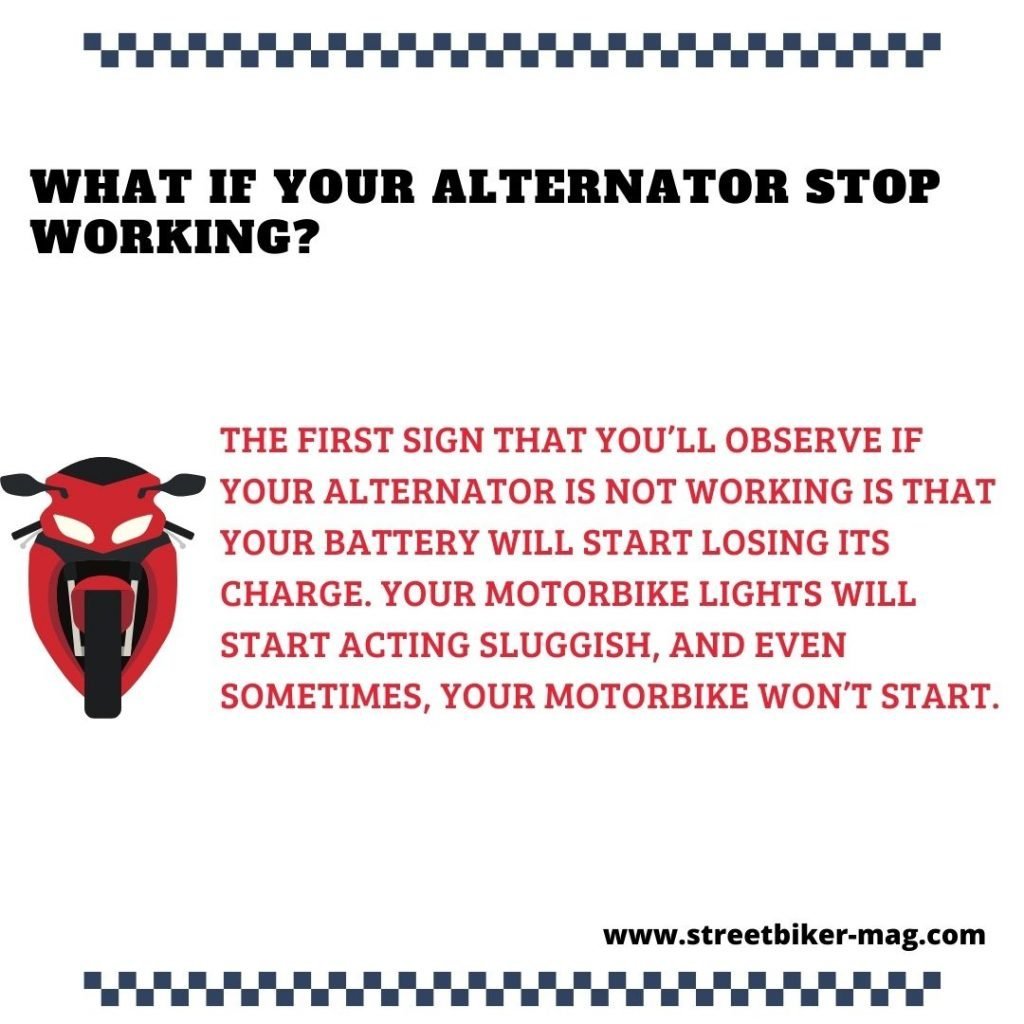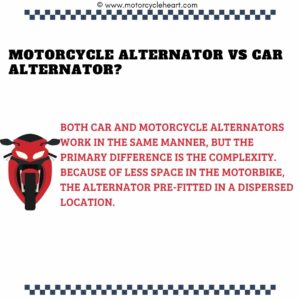The alternator is the common word that comes to mind when we ever hear the phrase motorbike battery. Now the question is, how does a motorcycle alternator work?
A motorcycle alternator works by converting the mechanical energy of a motorcycle into electrical energy. This electrical energy charges the battery.
But what is a motorcycle alternator, what are some parts of an alternator, and how does a motorcycle alternator work?
No worries! In this post, we’ve covered all your questions in brief.
What is a Motorcycle Alternator?
Before learning the functioning of alternators, you’ll have to understand what an alternator is.
A motorcycle alternator is a device found in a motorbike responsible for converting mechanical energy to electrical energy. The motorcycle alternator considers stator, magnet, and coil wire.
Although you can find the same unit in a car as well, at the car level, all units seem simple, while in the motorbike, all units are complex because of less space in the motorcycle.
What is a Stator?
A stator is the replaceable part of a motorcycle alternator that consists of a magnet on it. The stator is the main component in the motorcycle alternator, and without it, your motorbike alternator wouldn’t create an electrical charge.
How Does a Motorcycle Alternator Work?
As mentioned above, the motorcycle alternator works by changing the mechanical energy into electrical energy. But more precisely, the working of alternators is not so simple.
Alternators consist of three parts named as stator, flywheel, and coil. The function of the stator is to convert the AC produced through the flywheel into DC.
And the DC assures that your motorcycle devices can run smoothly.
The whole thing works with the principle of magnetism, and the entire unit contains two magnets. One on the flywheel and the second on the stator; please note that the magnet on the flywheel rotates around the stator magnet, thus creating an electrical charge.
So overall, the mechanical energy (created when you ride your motorbike) forces the flywheel to rotate around the stator, consisting of a magnet. This rotation helps to generate an electrical charge which is necessary to charge your motorcycle battery.
Mechanical energy created when you ride your motorcycle → Mechanical energy causing the flywheel to rotate around the stator. → This rotation creates an electrical charge by the principle of magnetism.
Now the problem is, the above process makes AC which batteries can’t store. So the manufacturers make the device fitted in an alternator called a rectifier. The rectifier or a regulator converts the AC into DC so that the battery can store electrical charge.
If you think you can find a regulator near the alternator, then you’re mistaken. Generally, manufacturers fitted the alternator in the way to air steam to cool the regulator.

Can You Run a Motorcycle Without an Alternator?
No, you can’t even run your motorcycle for one mile without an alternator. Try to understand that your motorcycle battery can’t store an enormous amount of charge.
Instead, your motorcycle battery can store charge, which is only necessary to ignite the motorcycle engine. So it’s common sense that your motorcycle battery requires continuous charging, which it gets when you ride your motorcycle.
What if Your Alternator Stop Working?
It’s too familiar for alternators not to work, especially if your motorcycle is old, then you might face this situation more frequently. Thus it’s essential for every ride to know some signs of a faulty alternator.
The first sign that you’ll observe if your alternator is not working is that your battery will start losing its charge. Your motorbike lights will start acting sluggish, and even sometimes, your motorbike won’t start.
The second sign that you may experience is the loss of power at high RPM. At high speed, your motorbike demands more energy than the battery probably couldn’t fulfill.
If you ever encounter a situation when your motorbike stops working when you give a race, then a faulty alternator could be the leading cause.

What is the Role of Battery?
Most people have the question: what is the role of a battery if the alternator generates the power itself?
Practically, no one can replace the battery with an alternator. Just like alternators, the battery also plays a vital role in the normal functioning of the motorcycle.
Your motorcycle battery is the only component solely responsible for starting the motorcycle for the first time.
As mentioned above, alternators work when your motorbike is in motion. And to bring the motorcycle into action, you’ll need to start the motorcycle, which you couldn’t do without the battery.
In other words, you wouldn’t be able to ignite the engine without the battery.
Motorcycle Alternator VS Car Alternator?
Till now, you’ve learned the proper functioning of motorcycle alternators and what if the alternator stops working. Now it’s prime to understand the fundamental difference between a car and motorcycle alternator.
Both car and motorcycle alternators work in the same manner, but the primary difference is the complexity. Because of less space in the motorbike, the alternator pre-fitted in a dispersed location.
You can spot the stator, alternator, and all other components in the same place in the car.
The second most significant difference is connectivity. Unlike motorbikes, the alternator system is indirectly connected to the engine by some belt system. While on the motorbike, you won’t find any belt system for the alternator.

How to Confirm that Your Stator has Malfunctioned:
Before reaching any conclusion, you need to know about some tests. The first step that you can do is to remove the engine cover and see the stator physically.
You can also read the motorcycle manual if you ever get stuck in this process.
After exposing the stator, note the overall stator condition. Observing the weather, is there any sign of burn? Are the copper wires in a safe condition, or are they melting? Check if there is any burn mark on the stator.
You can also confirm the malfunctioning of the stator by using the multimeter. If you have a multimeter, then we recommend unplugging the stator and connecting it to the multimeter.
After connecting the multimeter, start the motorcycle and change the multimeter reading to AC and check the reading.
The reading should be the same on each terminal. And if the readings aren’t the same on both tabs, then it’s clear that your stator has malfunctioned.
How Long You Should Ride to Charge the Motorcycle:
Usually, the motorcycle’s batteries charge well in the supply of 13.5V to 14.5V. In this sense, you need at least to ride a motorcycle for a couple of hours to charge the motorcycle battery considerably.
It’s just an obvious fact that charging the battery depends on the battery size and speed you ride the motorcycle.
The more RPM you’ll cover in the short duration, the faster your battery will charge. At the descent speed, the larger batteries charge slowly that little one. But you can boost the charging capacity of your motorcycle by turning off unnecessary accessories.
Like headlight in the daytime to focus the electric current in the charging of the battery solely. After all, the unnecessary accessories also drain the battery.
Frequently Asked Questions:
How does a motorcycle alternator work?
A motorcycle alternator works by converting the mechanical energy of a motorcycle into electrical energy. This electrical energy charges the battery.
What is motorcycle alternator?
Before learning the functioning of alternators, you’ll have to understand what an alternator is.
A motorcycle alternator is a device found in a motorbike responsible for converting mechanical energy to electrical energy. The motorcycle alternator considers stator, magnet, and coil wire.
Although you can find the same unit in a car as well, at the car level, all units seem simple, while in the motorbike, all units are complex because of less space in the motorcycle.
What’s the process of electrical current generation through mechanical energy?
Mechanical energy created when you ride your motorcycle → Mechanical energy causing the flywheel to rotate around the stator. → This rotation creates an electrical charge by the principle of magnetism.
What is the role of battery?
Your motorcycle battery is the only component solely responsible for starting the motorcycle for the first time.
As mentioned above, alternators work when your motorbike is in motion. And to bring the motorcycle into action, you’ll need to start the motorcycle, which you couldn’t do without the battery.
What’s the difference between car and motorcycle alternator?
Both car and motorcycle alternators work in the same manner, but the primary difference is the complexity. Because of less space in the motorbike, the alternator pre-fitted in a dispersed location.
The second most significant difference is connectivity. Unlike motorbikes, the alternator system is indirectly connected to the engine by some belt system. While on the motorbike, you won’t find any belt system for the alternator.
Final Verdict:
How does a motorcycle alternator work? A motorcycle alternator works by converting the mechanical energy of a motorcycle into electrical energy. This electrical energy charges the battery.
The whole thing works with the principle of magnetism, and the entire unit contains two magnets. One on the flywheel and the second on the stator; please note that the magnet on the flywheel rotates around the stator magnet, thus creating an electrical charge.

